初三英语时态复习共21页
- 格式:ppt
- 大小:1.34 MB
- 文档页数:11
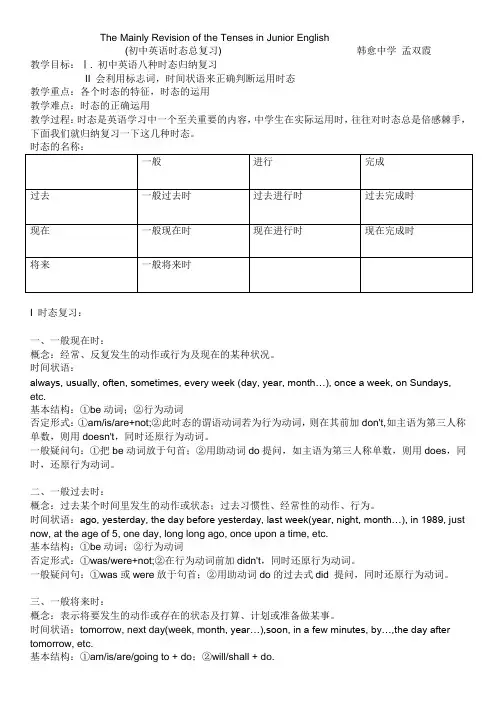
The Mainly Revision of the Tenses in Junior English(初中英语时态总复习) 韩愈中学孟双霞教学目标:Ⅰ. 初中英语八种时态归纳复习II 会利用标志词,时间状语来正确判断运用时态教学重点:各个时态的特征,时态的运用教学难点:时态的正确运用教学过程:时态是英语学习中一个至关重要的内容,中学生在实际运用时,往往对时态总是倍感棘手,下面我们就归纳复习一下这几种时态。
I 时态复习:一、一般现在时:概念:经常、反复发生的动作或行为及现在的某种状况。
时间状语:always, usually, often, sometimes, every week (day, year, month…), once a week, on Sundays, etc.基本结构:①be动词;②行为动词否定形式:①am/is/are+not;②此时态的谓语动词若为行为动词,则在其前加don't,如主语为第三人称单数,则用doesn't,同时还原行为动词。
一般疑问句:①把be动词放于句首;②用助动词do提问,如主语为第三人称单数,则用does,同时,还原行为动词。
二、一般过去时:概念:过去某个时间里发生的动作或状态;过去习惯性、经常性的动作、行为。
时间状语:ago, yesterday, the day before yesterday, last week(year, night, month…), in 1989, j ust now, at the age of 5, one day, long long ago, once upon a time, etc.基本结构:①be动词;②行为动词否定形式:①was/were+not;②在行为动词前加didn't,同时还原行为动词。
一般疑问句:①was或were放于句首;②用助动词do的过去式did 提问,同时还原行为动词。

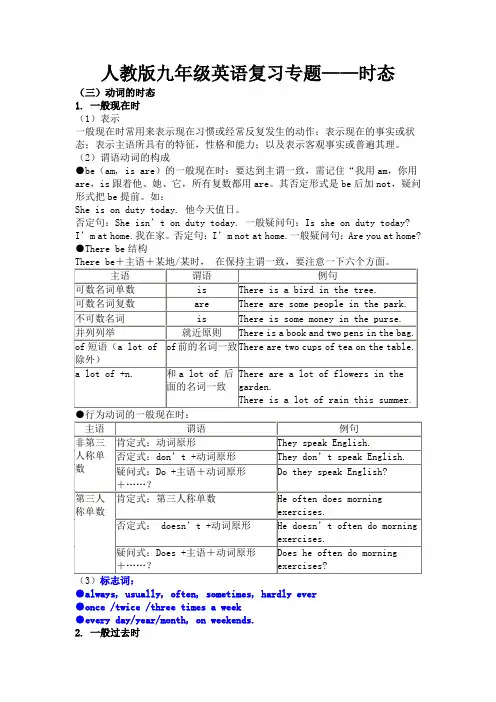
人教版九年级英语复习专题——时态(三)动词的时态1. 一般现在时(1)表示一般现在时常用来表示现在习惯或经常反复发生的动作;表示现在的事实或状态;表示主语所具有的特征,性格和能力;以及表示客观事实或普遍其理。
(2)谓语动词的构成●be(am, is are)的一般现在时:要达到主谓一致,需记住“我用am,你用are,is跟着他、她、它,所有复数都用are。
其否定形式是be后加not,疑问形式把be提前。
如:She is on duty today. 他今天值日。
否定句:She isn’t o n duty today. 一般疑问句:Is she on duty today? I’m at home.我在家。
否定句:I’m not at home.一般疑问句:Are you at home?●There be结构There be+主语+某地/某时,在保持主谓一致,要注意一下六个方面。
主语谓语例句可数名词单数is There is a bird in the tree.可数名词复数are There are some people in the park.不可数名词is There is some money in the purse.并列列举就近原则There is a book and two pens in the bag. of短语(a lot of除外)of前的名词一致There are two cups of tea on the table.a lot of +n. 和a lot of 后面的名词一致There are a lot of flowers in the garden.There is a lot of rain this summer.●行为动词的一般现在时:主语谓语例句非第三人称单数肯定式:动词原形They speak English.否定式:don’t +动词原形They don’t speak English.疑问式:Do +主语+动词原形+……?Do they speak English?第三人称单数肯定式:第三人称单数He often does morningexercises.否定式:doesn’t +动词原形He doesn’t often do morningexercises.疑问式:Does +主语+动词原形+……?Does he often do morningexercises?(3)标志词:●always, usually, often, sometimes, hardly ever ●once /twice /three times a week●every day/year/month, on weekends.2. 一般过去时(1)表示一般过去时表示过去发生的动作或存在的状态;或表示过去一段时间经常或反复发生的动作。
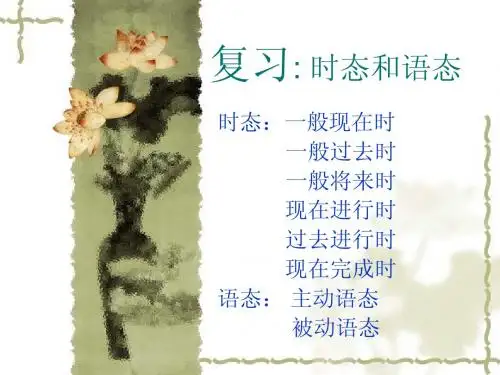
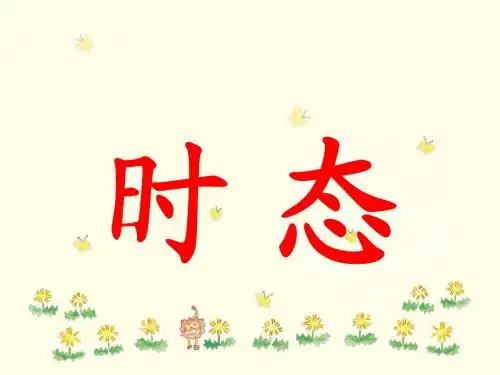
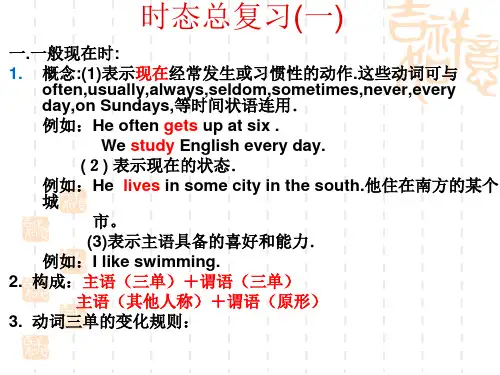
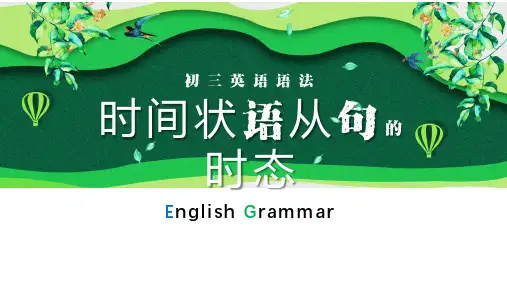
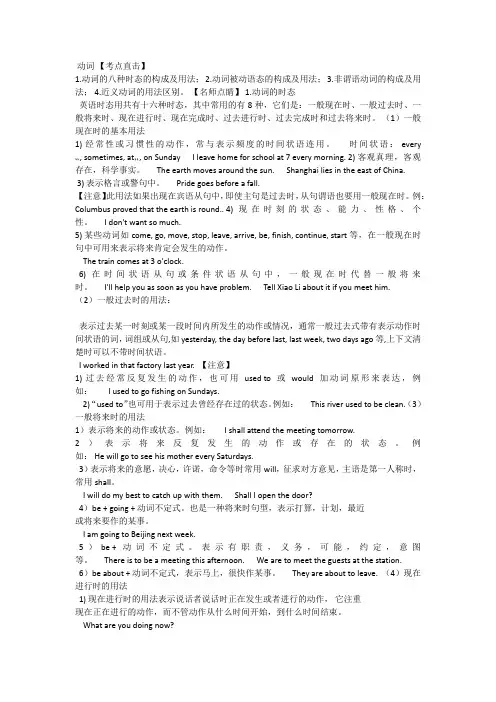
动词【考点直击】1.动词的八种时态的构成及用法;2.动词被动语态的构成及用法;3.非谓语动词的构成及用法;4.近义动词的用法区别。
【名师点睛】 1.动词的时态英语时态用共有十六种时态,其中常用的有8种,它们是:一般现在时、一般过去时、一般将来时、现在进行时、现在完成时、过去进行时、过去完成时和过去将来时。
(1)一般现在时的基本用法1) 经常性或习惯性的动作,常与表示频度的时间状语连用。
时间状语: every …, sometimes, at…, on Sunday I leave home for school at 7 every morning. 2) 客观真理,客观存在,科学事实。
The earth moves around the sun. Shanghai lies in the east of China.3) 表示格言或警句中。
Pride goes before a fall.【注意】此用法如果出现在宾语从句中,即使主句是过去时,从句谓语也要用一般现在时。
例:Columbus proved that the earth is round.. 4) 现在时刻的状态、能力、性格、个性。
I don't want so much.5) 某些动词如 come, go, move, stop, leave, arrive, be, finish, continue, start 等,在一般现在时句中可用来表示将来肯定会发生的动作。
The train comes at 3 o'clock.6) 在时间状语从句或条件状语从句中,一般现在时代替一般将来时。
I'll help you as soon as you have problem. Tell Xiao Li about it if you meet him.(2)一般过去时的用法:表示过去某一时刻或某一段时间内所发生的动作或情况,通常一般过去式带有表示动作时间状语的词,词组或从句,如 yesterday, the day before last, last week, two days ago 等,上下文清楚时可以不带时间状语。
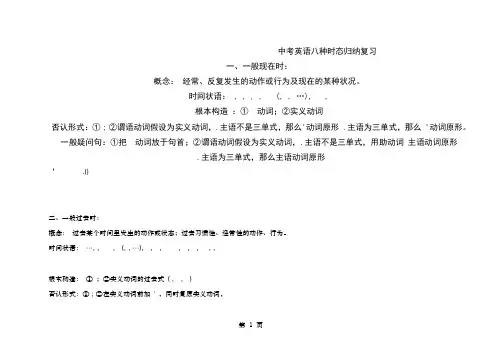
中考英语八种时态归纳复习一、一般现在时:概念:经常、反复发生的动作或行为及现在的某种状况。
时间状语:, , , , (, , …), ,根本构造:① 动词;②实义动词否认形式:① ; ②谓语动词假设为实义动词,.主语不是三单式,那么'动词原形 .主语为三单式,那么 '动词原形。
一般疑问句:①把动词放于句首;②谓语动词假设为实义动词,.主语不是三单式,用助动词主语动词原形.主语为三单式,那么主语动词原形’ .()二、一般过去时:概念:过去某个时间里发生的动作或状态;过去习惯性、经常性的动作、行为。
时间状语:…, , , (, , …), , , , , , , ,根本构造:① ;②实义动词的过去式( , , )否认形式:① ; ②在实义动词前加' ,同时复原实义动词,即’动词原形一般疑问句:① 或放于句首;②用助动词的过去式提问,同时复原实义动词。
.() .()三、现在进展时:概念:表示现阶段或说话时正在进展的动作及行为。
时间状语:, , , ,根本构造:否认形式: .一般疑问句:把动词放于句首。
, .()四、过去进展时:概念:表示过去某段时间或某一时刻正在发生或进展的行为或动作。
时间状语:, , ,或以引导的谓语动词是一般过去时的时间状语等。
根本构造:否认形式: .一般疑问句:把或放于句首。
.().()五、现在完成时:概念:过去发生或已经完成的动作对现在造成的影响或结果,或从过去已经开场,持续到现在的动作或状态。
时间状语:…… , , , , , (几年来,这么多年来),主〔现完〕从〔一过〕〔注意与的区别〕,根本构造:否认形式: .一般疑问句:或主语.()六、过去完成时:概念:以过去某个时间为标准,在此以前发生的动作或行为,或在过去某动作之前完成的行为,即“过去的过去〞。
时间状语:(, …) 过去的时间,主(过完)从(一过)根本构造: . 否认形式: .一般疑问句:放于句首。
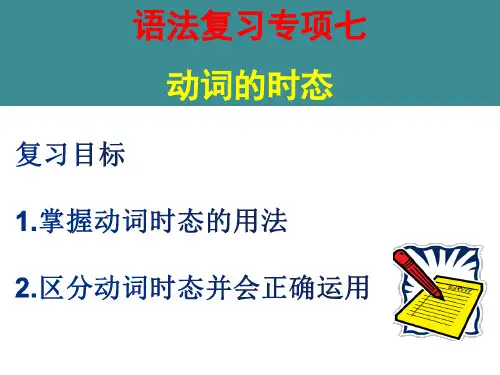
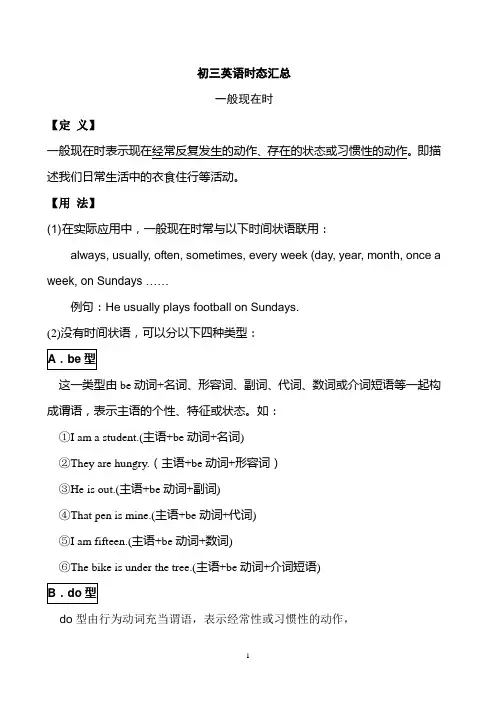
初三英语时态汇总一般现在时【定义】一般现在时表示现在经常反复发生的动作、存在的状态或习惯性的动作。
即描述我们日常生活中的衣食住行等活动。
【用法】(1) 在实际应用中,一般现在时常与以下时间状语联用:always, usually, often, sometimes, every week (day, year, month, once a week, on Sundays ……例句:He usually plays football on Sundays.(2)没有时间状语,可以分以下四种类型:这一类型由be动词+名词、形容词、副词、代词、数词或介词短语等一起构成谓语,表示主语的个性、特征或状态。
如:①I am a student.(主语+be动词+名词)②They are hungry.(主语+be动词+形容词)③He is out.(主语+be动词+副词)④That pen is mine.(主语+be动词+代词)⑤I am fifteen.(主语+be动词+数词)⑥The bike is under the tree.(主语+be动词+介词短语)do型由行为动词充当谓语,表示经常性或习惯性的动作,其构成为。
如:①I know it. ②He believes me.there be型句子表示“某地存在…”,其构成为,表示客观事实。
用法遵循,即主语是单数或并列主语中的第一个主语是单数,则用there is;主语是复数或并列主语中的第一个主语是复数,则用there are。
如:(1)There is an eraser on the teacher's desk.(主语an eraser是单数)(2)There is an orange,five apples and eight bananas in the bag.(并列主语中的第一个主语an orange是单数)情态动词型句子的构成为,情态动词和动词原形一起构成谓语,表示说话人对所叙述的动作或状态的看法。
时态复习动词时态包括:1、一般现在时2、一般过去时3、现在进行时4、现在将来时5、过去进行时6、现在完成时7、过去将来时8、过去完成时"一、一般现在时句型:1、主语(复数名词、代词:I、you ,they)+ 动词原形2、主语(单数名词、代词:he,she,it)+ 动词(加s、es)3、否定句、疑问句中的一般现在时}一般现在时与时间状语1、一般现在时表示经常性或习惯性动作。
常用的时间状语有:always, usually, often, never, sometimes, every(….), once a week, on Saturday2、在时间,条件状语从句中If it doesn’t rain tomorrow, we’ll go for a picnic.I will tell her the message as soon as I see her.·She wouldn’t stop crying until her mother came home.3、一般现在时表客观事实或普遍真理The teacher said that the moon is smaller than the earth.二、一般过去时[句型:1、主语+did/ 主语+ was、were2、助动词有:did/was/were;既行为动词没有主谓一致变化;be动词单数是was 复数是were3、熟记动词的过去时态形式'过去时及其用法1、一般过去时表过去某时发生的动作或存在的状态2、常见时间状语有:yesterday, last…,… ago,just now , in+过去时间, one day, at the age of, when例如:The boy began to learn English when he was five.;Jack often got up very late during the summer holiday.Did you visit the Great Wall while you were traveling in BJ三、现在进行时句型:1、/2、主语+(is, am, are)+现在分词(v-ing)3、现阶段“正在,在” 进行的动作,常用时间状语有:now, right now, at themoment, these days, look!例如:you moved into your new house---Not yet. It ____ (paint)there! Ma Ning ______(play) basketball alone.…四、现在将来时句型:1、主语+will do…or will be…主语+ (is am are) going…2、有些动词象:go, come, arrive, leave,start, die 等表示移动的动词,它们的进行时态形式表示将来{The Greens are leaving for Shanghai tomorrow.4、一般将来时表示“将,将要”来要发生的动作或状态,常用时间状语有:tomorrow, this afternoon , next week, in+一段时间五、过去进行时句型:,1、was/were + doing…2、过去某个“时间点” “正在,在” 进行的动作3、时间状语有:at seven yesterday morning, from 9 to 10 last night, at this time last Monday, when、while等例如:I was watching TV when my teacher came to my home.He was drinking with us when the killing happened.¥It was 8:00 now, and he was having his breakfast.六、现在完成时1.现在完成时:顾名思义,现在完成时表示的是已经完成的动作,但动作造成的影响还在,常被just,already,yet 等副词修饰。